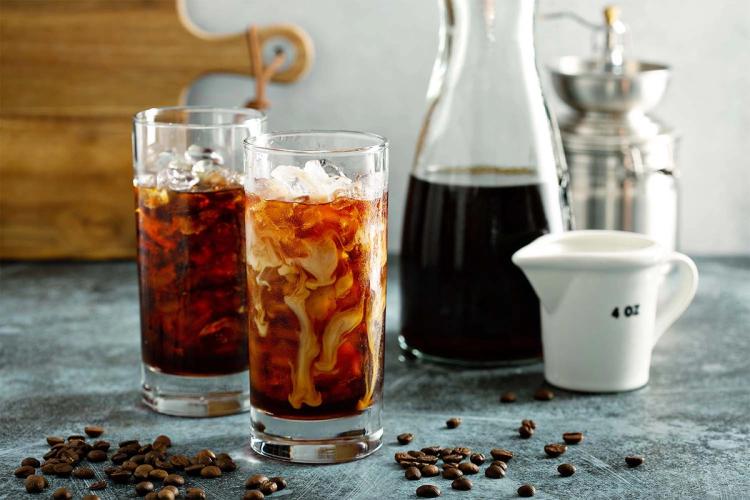
Cold Brew vs. Iced Coffee: Which To Go For?
Some people enjoy coffee black. Some enjoy coffee with cream and sugar. Some people enjoy regular drip coffee, while others prefer lattes.
The list of ways you can have your coffee is always growing. Not to mention the question of do you want your coffee “hot or cold,” which is actually a question of “hot, cold, or iced.” What is the difference between cold brew coffee and iced coffee?
For some, cold brew and iced coffee sound like the same thing. However, their flavors, brew methods, and prices are different, and there are several reasons why.
Read on and find out what makes each one of these drinks unique.
What Is Iced Coffee?
The history of iced coffee is a little spotty. Since it is simply hot coffee poured over ice, it is hard to distinguish who came up with the idea first.
However, there is some evidence that iced coffee was being made in the 17th century in Vienna when the Turks were passing through. In Western culture, iced coffee was not really widely popular until the early 2000s. Between 2009-2013, the iced coffee industry boomed, and it has continued to rise ever since.
How Is Iced Coffee Made?
Iced coffee is made by making hot coffee, letting it cool to room temperature, and then pouring it over ice.
The downfall of this method is that the coffee tends to taste burnt, acidic, and sometimes watery. You can’t taste the rich, natural flavor notes like you typically could if you drank the coffee when it was hot. The best way for you to make iced coffee quickly without any concern for losing flavor quality is through a flash brew method.
To flash brew, you use double the amount of coffee grinds you would use for a regular pot of coffee, and you fill a pitcher half full of ice. Once the drip is brewed, you pour the coffee directly over the ice-filled pitcher, and your coffee should be chilled and ready to be made into a cup of iced coffee.
Ratios and Roasts for Flash-Brewed Ice Coffee
The most prevalent ratio used in the flash brew method is 1:10; this means there is 1 gram of coffee per every 10 grams of water. To give a little perspective, the typical ratio for a regular pot of coffee or a pour-over is 1:17.
Flash brew is meant to be stronger, which is why there is less water per gram of coffee. For flash brewed coffee, the coffee should be ground to a medium-fine level. As far as what type of roast should be used in your iced coffee, that all depends on your personal flavor preferences.
A light roast will result in a more citrusy or fruity flavor. A medium roast will be more chocolatey, smooth, and may have some notes of cherry. A dark roast will be more bitter and potent.
Most flash brews do best with a medium to a dark roast. However, a light roast can be used if you prefer the fruitier flavors of a light roast.
Cold Brew
Which came first, iced coffee or cold brew? Ironically, they are both credited with being first incorporated into coffee in the 17th century. However, iced coffee was created in Europe, and cold brew was created in Japan.
Cold brew was first made via the Kyoto method. The Kyoto method uses ice water, coffee grinds, and what looks like a chemistry class glass spiral. The water travels through the spiral and drips very slowly over the coffee grinds at about one drop of water per second.
The cold brew takes over 24 hours to make, and since it is extracted over such a long period of time, it is extremely strong and condensed.
How To Make Cold Brew
Cold brew never touches heat and normally takes about 16-20 hours to make, whereas flash brew iced coffee is made quickly with hot coffee poured over ice. Cold brew may be more time-consuming, but it is less acidic due to the long extraction period.
Cold brew is made similarly to iced tea. It is coarsely ground coffee placed in a filter, which is steeped in cold water for up to 20 hours. If it is steeped longer than 20 hours, it can become over-extracted and taste sour.
It uses the same ingredients as flash brewed iced coffee, coffee grounds, and water. However, it does not contain ice, and it never uses heat.
After waiting 20 hours for the grinds to steep in the water, remove the filter, pour over a cup of ice, and enjoy your cold brew!
Ratios and Roasts for Cold Brew
For cold brew, the ratio is 1:4. That means it uses more coffee than even flash brew. Combine the fact that cold brew is steeped for 16-20 hours, and you’ll find it results in an extra strong drink.
Cold brew brings out the naturally sweet flavor notes of coffee, and it is typically made with a medium-dark roast. Any roasts containing more chocolatey, caramel, and nutty flavors are best for cold brew since it enhances the natural flavors through the extraction process.
When making cold brew, be sure to coarsely grind the coffee so the water can break down the grinds quicker during the long extraction period.
Which Is Better: Cold Brew or Iced Coffee?
Flash brew iced coffee and cold brew are both great cold coffee options. Both can bring out different flavors and are delicious with additional add-ins.
However, are there more differences besides how they are made? Now that we have broken down the basic differences between cold brew and iced coffee, we can dive into which one might offer more health benefits.
Iced Coffee vs. Cold Brew: Health Benefits
Coffee is known for containing a lot of antioxidants as well as long-term health benefits. It’s linked to a Coffee is known for containing a lot of antioxidants as well as long-term health benefits. It’s linked to a lower risk of type-2 diabeteslower risk of type-2 diabetes and may even and may even lower the risk of certain cancerslower the risk of certain cancers..
The same benefits are there for both hot and flash brew iced coffee. However, since they go through a heated brewing process, they lose some of the beneficial antioxidants in the process.
The cold brew extraction process doesn’t use heat, which makes it less acidic than regular flash-brewed iced coffee. However, this also results in the loss of even more of its antioxidants from the long steeping time.
Pros and Cons
Each version ofcold coffee is delicious and beneficial. One may be more antioxidant-rich, and the other may be less acidic and better for your stomach in the long term.
However, depending on how you drink your coffee, whether with cream, sugar, extra flavors, and add-ins, your coffee may not be as beneficial as you imagine. All of the little things add up quickly, so just remember moderation is key.
There are some days you may need more of an energy boost, and cold brew is known to contain more caffeine. This is because it typically contains more coffee per ounce. Either way, whatever your mood, iced coffee and cold brew are both great options to start your day or have as an afternoon pick-me-up!
Coffee Costs
The price difference between iced coffee and cold brew is based on the quantity of coffee and labor that goes into cold brew. Cold brew is more expensive because it contains more coffee per ounce. It also takes more time to prepare.
Flash brewed iced coffee still contains more than regular drip coffee. However, the time and prep work needed to make flash brewed ice coffee is significantly less than cold brew, resulting in lower prices. If your budget is tight, maybe switch the cold brew out for some iced coffee instead of giving up your coffee craving altogether!
Cold Brew vs. Iced Coffee: The Finale
There are pros and cons in every area of life. The battle between cold brew and iced coffee relies heavily on each person’s specific taste preferences. Iced coffee is more acidic and tangy, whereas cold brew is naturally smooth and tastes sweeter by itself, leaving less need to fill it with cream and sugar.
Depending on the day, the weather, or your mood, one coffee may be more appealing than the other. However, at the end of the day, both contain health benefits, both are delicious, and both are great ways to share a cup of coffee with a friend.
Sources:




